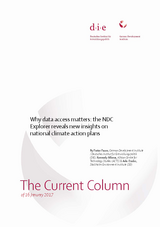Die aktuelle Kolumne
Why data access matters: the NDC Explorer reveals new insights on national climate action plans
Pauw, Pieter / Kennedy Mbeva / Adis DzeboDie aktuelle Kolumne (2017)
Bonn: German Development Institute / Deutsches Institut für Entwicklungspolitik (DIE) (The Current Column of 16 January 2017)
The UN climate summit in Paris in 2015 was a diplomatic triumph, built on national climate action plans of 190 countries. Known as (intended) Nationally Determined Contributions (NDCs) in UN jargon, these documents offered a clear signal that the world aims for a low-carbon and resilient future. The UNEP emission gap report shows that implementing all NDCs would limit global warming to around 3°C by 2100 - 0.6°C less than before the NDC-era. However, beyond this overall temperature effect, surprisingly little is known about the diverse contents of NDCs. Are they really a game-changer? With the NDC Explorer, an online visualisation tool, we aim to create more transparency about countries’ ambitions and priorities. When focusing on overall mitigation targets of NDCs, a bulk of information on issues beyond mitigation is neglected. Since there is no agreed template or method for preparing the NDCs, their scopes and contents vary widely. Even their length varies from 3 pages to almost 60 pages. Looking at NDCs in a broader and more analytical light is important for two reasons. First, we need to understand countries’ broader ambitions and the context in which they are developed. Second, for NDCs to become a durable key instrument we have to be able to track their implementation, and we have to make sure that the next round of NDCs (planned for 2020) is more ambitious than the current one. A project of DIE, ACTS and SEI therefore analysed ambitions and priorities from all NDCs. We built a database, in cooperation with the UNFCCC secretariat, including 60 subcategories on mitigation, adaptation, finance and support, planning and process, as well as the ‘broader picture’ to reveal links to other international debates, such as green growth and the Sustainable Development Goals (SDGs). Via the new interactive online NDC Explorer, this database is made accessible for all. Transparency and data access matters in climate action So what do we see from this analysis? We have arrived at some surprising results that clearly need to be addressed if NDCs are to be a sustainable game changer in international climate policy. We provide four examples below. First, mitigation contexts. It is hardly surprising that renewable energy is a focus area for countries of all levels of development. Many countries go further and indicate targets for particular sources of renewable energy. This is useful information for investors and development organisations. However, other high-emission sectors like transport and agriculture are a priority area in as little as 15 and 4 NDCs, respectively, despite these sectors being important sources of greenhouse gas emissions. Second, almost all NDCs go beyond mitigation in various ways. For example, 85% of all NDCs mention adaptation to climate change impacts. Many NDCs go further and include indications of vulnerable sectors and priority sectors for adaptation, such as water and agriculture. Such priorities are cascading: the poorer a group of countries, the stronger its focus on adaptation. The same accounts for indications of finance needs. When looking at the World Bank regions, 79% of the countries in Sub-Saharan Africa make the implementation of their mitigation target partly or fully conditional upon receiving international support. In ‘South Asia’ this percentage is 75%, and in ‘Middle East and North Africa’ only 45%. Third, many NDCs also linkages to other important international debates. This sets the agenda and opens doors for mainstreaming. For example, countries like Nigeria, Saudi Arabia and Venezuela mention plans for fossil fuel subsidy reform. Twenty-four NDCs – predominantly of low-income countries – write about climate-change-related migration. Only ten countries write about the Sustainable Development Goals explicitly, but that might be explained by the fact that Agenda 2030 was still under development when countries formulated their INDCs. Finally, only a third of the NDCs refer to some kind of monitoring, assessment or review of their NDC implementation. Only 11 NDCs make references to an international assessment and review processes. It is worrying that so few countries plan to measure progress on the implementation of this key instrument of the Paris Agreement. Whilst we continue to believe that NDCs have the power to determine the climate politics and policies for years to come, more emphasis needs to be put on aspects beyond the overall mitigation targets. Transparency is the basis for understanding the NDCs, and crucial to develop common methods and metrics as well as tracking efforts of support and implementation. We hope the NDC Explorer provides a useful tool for the global community to contribute to this development. You can find the new NDC Explorer here. Kennedy Mbeva is a research fellow on Climate Resilient Economies/Responsible Natural Resource Economiesat at the African Centre for Technology Studies (ACTS). Adis Dzebo is a researcher at the Stockholm Environment Institute (SEI) and co-leader of the SEI Initiative on Climate Finance.

